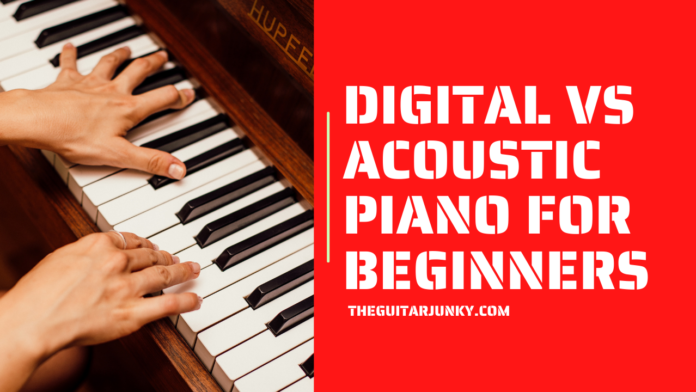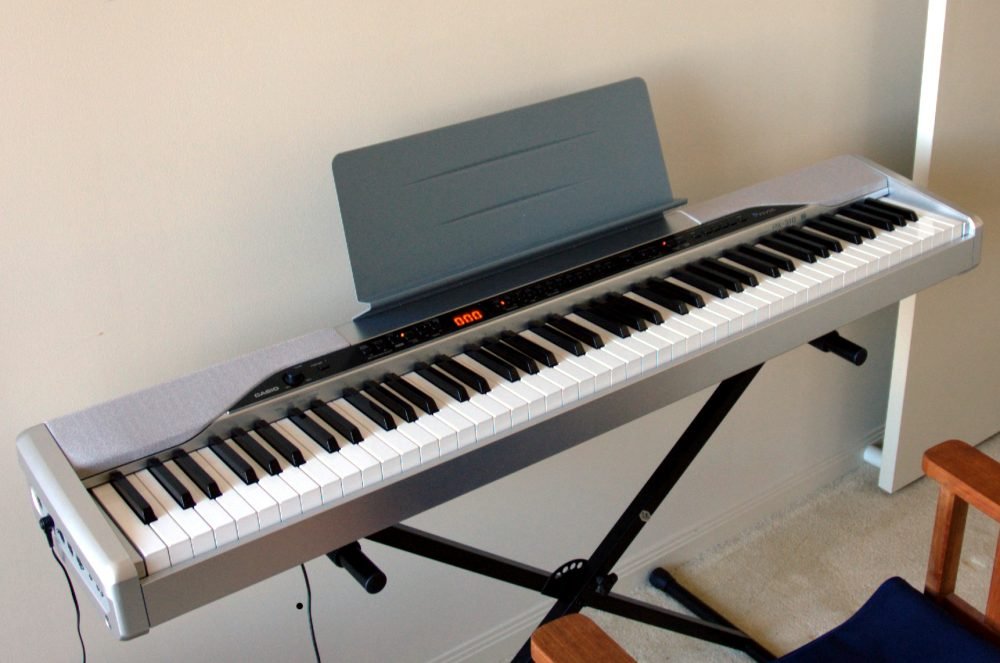Quick Answer: Either is better because it depends on your budget, purpose, and space. Acoustic pianos are more expensive and bigger than a digital piano. For beginners short on budget, maybe start with a digital piano, then later have the acoustic one. But, if you have the money, go get an acoustic.
Contents
What is an Acoustic Piano?
If you’ve seen that big wooden cabinet where the pianist sits in front and play, that‘s an acoustic piano.
There are two types of an acoustic piano — acoustic grand piano and the acoustic upright piano. What you usually see on stage and in an ensemble is the acoustic grand piano.
Like acoustic guitars, acoustic piano uses steel strings. You can’t see them outside because they are enclosed by the wooden exterior.
In addition to the steel strings, it has hammers. The keys (white and black) are connected to the hammers that’ll strike the strings which cause vibrations.
These vibrations are transmitted to the soundboard, which amplifies the sound. The pianist can give expression by varying the force, speed, and release applied to the keys.
What is a Digital Piano?
A modern version of an acoustic piano, the digital piano produces sound digitally. This means that there are no strings nor hammers.
Actually, Yamaha digital pianos have hammers, but their purpose is not to strike the strings.
They are there to capture the dynamics of the keys, which in return offer a dynamic response to the touch, like the acoustic piano.
The common term for this is weighted keys. The keys are now sensitive to the pressure and speed, so you can hear loud or soft sounds.
What a digital piano has are recorded sounds from an acoustic piano.
So, when a key is pressed, the sensors capture the most delicate movements of the keys, then the recorded sounds will play in a speaker.
You can add acoustic effects to recreate the sounds of an acoustic piano, like reverb using digital technology.
Some digital pianos are even installed in a cabinet-style console like an acoustic one. But, they are generally smaller compared to the upright piano.
It comes in three types — upright, grand, and the portable keyboard pianos.
Acoustic vs. Digital Piano – A Detailed Comparison
Aside from their mechanism of producing the sound, they also differ in a few more aspects.
And, depending on your purpose, you’ll be able to see their similarities and differences, helping you decide which to pick.
Touch and Feel
If you put the acoustic and digital piano side by side and visually check the keys, you can’t see any difference. Both of them have white and black keys. But, if you play them, that’s the time that you can compare them.
 Acoustic piano is weighted. This means you have to exert a bit of strength to get the desired sound and volume of the keys.
Acoustic piano is weighted. This means you have to exert a bit of strength to get the desired sound and volume of the keys.
Try to strike the keys softer and you’ll get a soft sound. Press them harder and you’ll get a loud sound.
However, you can’t do this in a digital piano. No matter how soft or hard you push the keys, you’ll still get the same feel.
Hence, manufacturers are now redesigning their digital piano to have weighted keys like an acoustic.
Although there are now digital pianos that are both touch and pressure-sensitive, they can only recreate a few piano tones.
And, players can’t be as expressive as they are when playing a real acoustic piano.
Sound
It’s no surprise that an acoustic piano has excellent sound quality. You’ll get an authentic acoustic sound, which is warmer and more resonant.
Since you can control the strength and the speed you exert to the keys, you are more expressive and articulate.
The digital piano, on the other hand, only mimics the sound capability of the acoustic piano. Since the sounds are stored in a digital file, they don’t have the same nuances as the acoustic sounds.
A good digital piano is even better than a bad acoustic piano. However, even the best digital piano cannot beat a good acoustic piano.
Versatility
While a digital piano lacks in terms of tonal quality, it excels in versatility.
Since the sounds from this type of piano are recorded, you can have access to a wide range of musical instruments.
If you want to have drum sounds, you can do so. Your keyboard will be transformed to get a beat when striking a key.
Another great feature of a digital piano that isn’t found in acoustic is the ability to record directly to your computer.
Most digital pianos have a port that allows you to connect easily to your computer where you can save your file or edit them with music software.
Some digital pianos have a headphone output, which allows you to practice without disturbing others. It has a volume knob to control the volume if you don’t want others to hear you play.
Lastly, it’s portable. Generally, all digital pianos are lighter compared to an acoustic piano. Even one person can move it around.
You can bring them to your gigs and performances without bringing the big cabinet consoles.
Maintenance
Acoustic pianos have over 12,000 individual parts, so they need more attention than digital pianos.
In addition, an acoustic piano needs to be tuned, while a digital one doesn’t.
With temperature and humidity fluctuations, the acoustic piano can go out of tune.
Price
When you buy an acoustic piano, you’re investing in your instrument and your talent.
If you need an excellent piano, you should be ready to spend around $10,000 for upright and up to $85,000 if you want an acoustic grand piano.
Yet, you can also have a decent acoustic piano with a budget between $1,000 to $3,000. Additionally, you can rent them or buy a used one for a much lesser price.
On the other hand, if you think that playing piano could be your next hobby, get a digital piano.
The best ones cost you from $1000 to $3000, which closely resemble their acoustic counterparts.
But, if you’re on a budget, you can grab a playable digital piano between $300 to $500.
Benefits
| Acoustic Piano | Digital Piano |
|
|
Conclusion
Now that you know the differences between the two, it’s very easy for you to pick. For those who don’t have a grand at the moment and in need of a piano, a better alternative would be a digital piano.
However, if you are serious about learning piano and you have the money, why not invest in an acoustic piano?
Both pianos have unique features that some players like.
For example, the versatility of the digital piano will be the choice of those frequently go to gigs.
On the other hand, an acoustic piano will attract beginners who’ll use the instrument at home.
The better piano is the one that invites the beginner to play and learn faster.



